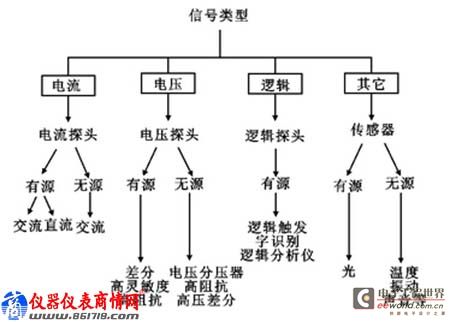1. Probe classification






Keywords:Oscilloscope
Reference address:How to achieve the best match for oscilloscope probes?

1.11.1

For example, the ZDS2024PLUS comes standard with the ZP1025S high-impedance passive voltage probe, and its specific parameters are as follows:
1.21.2

The following table shows the specific parameters of common high-voltage differential probes:

1.31.3

The advantage of the current probe is that the current can be measured without disconnecting the power supply line. Typical applications are system power measurement, power factor measurement, and switch impact current waveform measurement. The main disadvantage is that its small current measurement capability is limited by the bottom noise of the oscilloscope, so the small current measurement capability is limited.
Previous article:Effect of Frequency on Electrical Measurement Accuracy
Next article:What is the difference between a voltmeter and an oscilloscope?
- Popular Resources
- Popular amplifiers
Recommended Content
Latest Test Measurement Articles
- Seizing the Opportunities in the Chinese Application Market: NI's Challenges and Answers
- Tektronix Launches Breakthrough Power Measurement Tools to Accelerate Innovation as Global Electrification Accelerates
- Not all oscilloscopes are created equal: Why ADCs and low noise floor matter
- Enable TekHSI high-speed interface function to accelerate the remote transmission of waveform data
- How to measure the quality of soft start thyristor
- How to use a multimeter to judge whether a soft starter is good or bad
- What are the advantages and disadvantages of non-contact temperature sensors?
- In what situations are non-contact temperature sensors widely used?
- How non-contact temperature sensors measure internal temperature
MoreSelected Circuit Diagrams
MorePopular Articles
- LED chemical incompatibility test to see which chemicals LEDs can be used with
- Application of ARM9 hardware coprocessor on WinCE embedded motherboard
- What are the key points for selecting rotor flowmeter?
- LM317 high power charger circuit
- A brief analysis of Embest's application and development of embedded medical devices
- Single-phase RC protection circuit
- stm32 PVD programmable voltage monitor
- Introduction and measurement of edge trigger and level trigger of 51 single chip microcomputer
- Improved design of Linux system software shell protection technology
- What to do if the ABB robot protection device stops
MoreDaily News
- Detailed explanation of intelligent car body perception system
- How to solve the problem that the servo drive is not enabled
- Why does the servo drive not power on?
- What point should I connect to when the servo is turned on?
- How to turn on the internal enable of Panasonic servo drive?
- What is the rigidity setting of Panasonic servo drive?
- How to change the inertia ratio of Panasonic servo drive
- What is the inertia ratio of the servo motor?
- Is it better for the motor to have a large or small moment of inertia?
- What is the difference between low inertia and high inertia of servo motors?
Guess you like
- [RVB2601 Creative Application Development] Configure serial port 1 UART1 echo
- Introduction to TMS320C25's memory allocation and other hardware
- Calculate the reasonable setting of mesh ratio
- After copper plating, DRC reports an error
- ①、Development board received
- Industry 4.0 will become the dominant application of IoT within 5 years, what do you think???
- EEWORLD University - Inverter Principle
- Bluetooth and MSP430 Audio Sink Reference Design
- Apprentice
- 【ST NUCLEO-G071RB Review】TIM-Basic timers

 AD8047AR-REEL7
AD8047AR-REEL7












 京公网安备 11010802033920号
京公网安备 11010802033920号